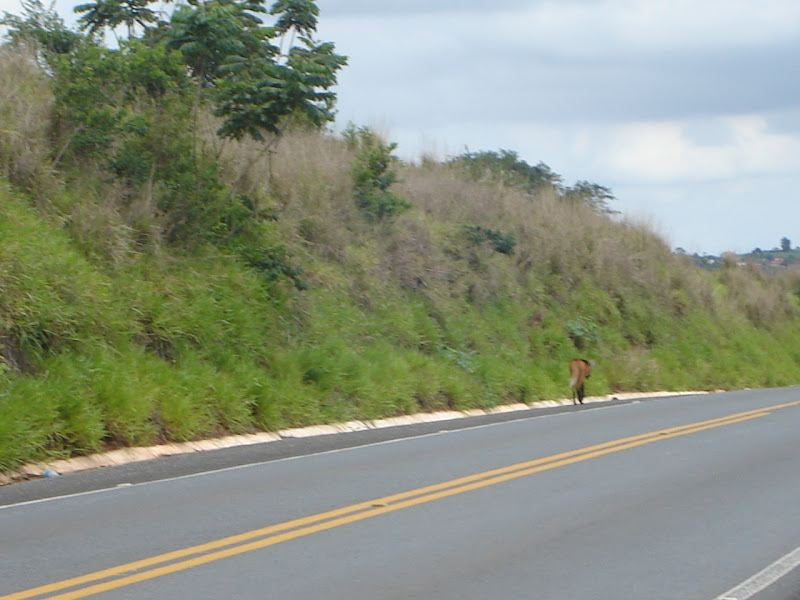My amazing encounter with the Maned Wolf.
I posted five years ago a post about the Maned Wolf, but I think that many of you maybe did not saw it. I did some updated and today I post it again. I hope all of you enjoy to know more about this near threatened specie.
Meu incrível encontro com o Lobo-Guará.
Cinco anos atrás fiz um post sobre o Lobo-Guará, mas penso que muitos de vocês não tiveram a oportunidade de vê-lo. Fiz algumas atualizações e estou postando novamente. Espero que vocês gostem de saber um pouco mais sobre esta espécie ameaçada.
These three photos below were taken by my husband, in December, 8, 2007, when we was going to a village near our house to pick up the newspaper. Suddenly we see a creature walking in the road and at first sight I thought it was a calf. When we come closer we saw that it's a Maned Wolf, a Lobo-Guará, in Portuguese. We both was amazed seeing, free at nature and so closer, this amazing species Near Threatened. The wolf looks tired and scared... Many trucks and cars were running very fast in the road and I was so much concerned for his security and life. Carlos can took few photos only. The quality of the photos were not so good, but I was so glad that he did!
Estas três primeiras fotos abaixo foram tiradas pelo meu marido, quando íamos à cidade próxima, para buscar os jornais. De longe pensei que esse animal que andava pelo acostamento da estrada fosse um bezerro desgarrado, mas chegando mais perto, vimos que era um Lobo-Guará. Ele parecia cansado e perdido naquela estrada.... Fiquei maravilhada e ao mesmo tempo triste e preocupada ao ver um animal tão bonito, que corre alto risco de extinção, estar assim perdido, correndo um risco enorme de morrer atropelado... 
The Maned Wolf (Chrysocyon brachyurus) is the largest Canid of South America. It is called Lobo-Guará ("Guará Wolf") in Portuguese. The common name, ‘maned wolf', is derived from the characteristic mane-like strip of black fur running from the back of the head to the shoulders, which stands erect when danger is sensed. The fur is shaggy and golden-red in color; it has a long, pointed muzzle and large, erect ears. It’s extremely long, thin legs are black and make the maned wolf immediately recognizable. It’s throat, inside of the ears and tip of the tail are white. The adult animal stands almost 1 m (3 ft) tall at the shoulder, and weighs 20 to 25 kg. (50 to 55 lb). Although their range in known to extend from NE Brazil, south through Paraguay and west into Peru, it is not known how many Maned Wolves survive in the wild. In Brazil this species is found in the Cerrado, a large area of open woodland and savannah that is one of the world's most important 'hot-spots' for biodiversity.
Shy and nocturnal: Contrary to popular belief maned wolves aren't generally fearless predators, but are rather shy, they are wary of man and do not attack unless provoked. The maned wolf hunts at night, with activity peaks at dusk and dawn, and rests during the day in areas of thick bush cover. Maned wolves are primarily nocturnal and have crepuscular activity peaks. The diet consists of a wide variety of fruits and small mammals, such as armadillos and rabbits, but also includes occasional birds, reptiles, insects, fish and arthropods. The wolf's main source of food is the tomato-like lobeira fruit, (Solanum lycocarpum) which provide medicinal aid against the giant kidney worm, Dioctophyme renale.
Solitary and monogamous: Unlike other wolves that live in cooperative breeding packs, the maned wolf is primarily solitary. Maned wolves are monogamous, though males and females tend to live independently except during the breeding season. Captive individuals have lived up to 15 years
Near Threatened: Maned Wolf is classified as Near Threatened. At present it is not known how many maned wolves remain in the wild. Threats to their survival include hunting and habitat loss. As its habitat is encroached upon by ever-expanding farms, the wolf is forced into increased proximity with people, exacerbating the already-existing conflict. In addition maned wolves are often killed on highways. Domestic dogs also pose a threat by transferring diseases, competing for food, and even killing the maned wolf.


O Lobo-Guará (nome científico Chrysocyon brachyurus) é o maior mamífero canídeo nativo da América do Sul. Apesar do nome, ele não é um lobo, mas uma espécie distinta adaptada ao Cerrado. A sua distribuição geográfica estende-se pela América do Sul e no Brasil nas regiões Sul, Sudeste e Centro-oeste. O Lobo-Guará mede até cerca de 1 metro no ombro e pesa entre 20 e 25 kg, tendo entre 1,45 e 1,90 m de comprimento total e 80 cm de altura do chão à cernelha. Suas orelhas são grandes e ele tem pernas longas. Sua pelagem característica é avermelhada por todo o corpo, exceto no pescoço, pernas e patas que são negras, e a ponta da cauda que é branca.
Solitário, noturno e monógamo: Ao contrário dos lobos, esta espécie não forma alcatéias e tem hábitos solitários, juntando-se apenas em casais durante a época de reprodução. A reprodução se dá uma vez por ano, sendo que em cada cria nascem de 1 a 6 filhotes. É um animal tímido e dificilmente se aproxima do ser humano. É mais ativo ao entardecer e durante a noite. O Lobo-Guará caça preferencialmente de noite e ataca pequenos mamíferos roedores e aves. Na sua dieta eles necessitam alimentar-se de um fruto da planta lobeira (Solanum lycocarpum), que serve como um vermífugo natural contra a parasitose renal provocada por um nematóide. Na ausência desse fruto, o animal morre de complicações renais. Ele é também um importante dispersor de sementes. Sua longevidade é de cerca de 15 anos em cativeiro.
You can read more about the Maned Wolf (Lobo-Guará) HERE and HERE



It is awesome seeing wild creatures like that, and worth getting some photos even if they're not perfect. It reminds me of when I ran across mama bear with her two cubs while hiking one time (within 20 meters of me), but all the photo shows is a bear-shaped blur; yours are much better than that. And I didn't even photograph the mountain lion I saw last summer!
ReplyDeleteWhat wonderful photos of such a lovely animal and an endangered one at that. Thanks for sharing.
ReplyDeleteAnne xx
What a beautiful creature! And lucky that your husband could take some photos. I have not heard of the Maned Wolf before. It's sad that it is an endangered species.
ReplyDeleteWhat a wonderful experience! I would love to see one someday.
ReplyDeleteWell spotted! I believe we saw one of these in the Pantanal. It was dark and we were on our way back to the lodgings after a night safari when our guide pointed it out to us. If we'd been alone, I would have thought it was a fox! It's so exciting when we get to spot something in the wild, though a wolf on a road... it's not exactly a wild or safe place to be! X
ReplyDeleteWhat a beautiful creature Sonia, and so sad that it is threatened and sad to see this one was a little lost and scared. I hope it is ok and has found a mate and lives a good and long life in its natural environment.
ReplyDeleteAn amazing thing to see for you and Carlos.
Good wishes
from Rose
Lindas fotos e fizeste um belo apanhado sobre ele. Legal de ver e ler,saber! beijos praianos,chica
ReplyDeleteBeautiful animals...hoping they can be better protected.
ReplyDeleteThanks for refreshing pictures & narrative about your encounter with the Maned Wolf. It is such a splendid looking animal and it is a pity that this animal is threatened with extinction.
ReplyDeleteThis is why I enjoy blogs so much. You can learn so many facts about people, places and things in personal, unfiltered ways.
ReplyDeleteSuch an amazing sighting, Sonia!
ReplyDeleteGosh, that's a sad story. Beautiful reddish-blond bay of an animal, with the black points on the legs and mane. The face bears a resemblance to our Western Coyote, though coyotes are very successful living close to human civilization. I'm always thrilled to see one.
ReplyDeleteSonia, que incrível!
ReplyDeleteE como ele é lindo!
Que cena!
Também fiquei triste; parecia mesmo muito assustado, indefeso...
Beijos.
Cara Sonia,
ReplyDeletebelíssimo post!
Pena que esta espécie esteja em vias de extinção.
Abraço
Dear Sonia
ReplyDeleteThank you very much for very interesting report
and pictures about the Maned wolf.
The Maned wolf is similar in appearance
to the red fox (Vulpes vulpes)in our region.
However, the long and thin legs make the
Maned wolf immediately recognisable as different species.
Wonderful to see a wild animal closeup.
Gisela
An amazing encounter, Sonia! Thanks for sharing these nice images, so interesting, of the Maned Wolf.
ReplyDeletebeautiful
ReplyDeleteLOVE! I don't know if you know that our wolves are threatened in America...they used to be in ever state, but with mass killings and now 'state allowed hunting' (like deer and elk are). Many are saying that there is no need to 'hunt' our predators. Balance of our Earth just really is getting OFF balanced! So, I just love when I see these beautiful animals just roaming in the wild :)
ReplyDeleteWhat an amazing animal. I once spotted an armadillo in the Caribbean. I gazed at it and watched it walk by and disappear into the hills. It was amazing too.
ReplyDeleteMelanie
Triste realidade que espalha pelo mundo. Importante relato e cabe a cada um de nós fazermos algo e não esperar somente de algum órgão governamental.Todos nós dependemos um do outro e está mais do que na hora de deixar a discussão e partir para prática. Aqui em Riviera de Sta Cristina XIII, desmatamento por causa do loteamento está acabando com lobo guará, raposa e tamanduá, além de outros. Todas as noites levo frutas para alimentá-los mas isso não basta.
ReplyDelete